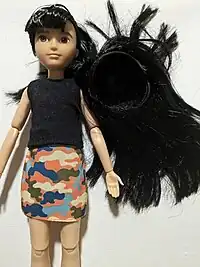Creatable World
Creatable World is the first line of gender-neutral dolls produced by Mattel. Creatable World dolls differ in design from other dolls produced by Mattel. The design of the doll is unique and is noticeably different from both Barbie and Ken; there are no curves or broad shoulders present on the dolls.[1] The doll does not have breasts like Barbie does and has other features that do not display an obvious gender. The dolls are designed to be versatile: with wigs to change hairstyles and a variety of clothing options.[2] Research and design for the doll line's development took 18 months.[3] Mattel tested the product with focus groups that included children with a variety of gender identities.[4]
  A Creatable World doll alongside a wig for different hair length | |
| Type | Gender-neutral dolls |
|---|---|
| Company | Mattel |
| Country | United States |
| Availability | 2019–present |
| Official website | |
Overview
The dolls are sold in kits, and 6 different kits are currently part of the doll line. The kits offer several customization options, including different hairstyles, clothes and accessories that are intended to offer a variety of both feminine- and masculine-presenting play options.[5] The dolls are designed to be versatile: with wigs to change hairstyles, and a variety of clothing options.[2] According to Kim Culmone, the senior-vice president of Mattel Doll Design, Creatable World is "an opportunity for us to open up that dialogue around what dolls are for and who dolls are for".[5] Michelle Condoni, a spokeswoman for Mattel, has stated that "we see this is as something that's all about play and not about politics".[3]
Reception
A 2017 survey conducted by the Pew Research Center found that approximately 76% of Americans supported girls pursuing interests perceived as masculine and approximately 64% of Americans supported boys pursuing interests perceived as feminine. There were differences based in responses from different political affiliations: approximately 84% of Democrats supported girls pursuing masculine interests compared to approximately 66% of Republicans. Responses also varied by gender: approximately 58% of Republican women supported boys pursuing feminine interests, in contrast to approximately 38% of Republican men.[6] A 2019 consumer survey of approximately 700 adult shoppers indicated that 25% expressed a positive view of gender-neutral toys and that 5% were interested in purchasing dolls from the Creatable World line as a holiday gift.[7]
Creatable World was praised by Jess Day, a campaigner for Let Toys Be Toys, who hoped that more toy manufacturers would follow suit in the future and avoid gender stereotypes. Day stated that "Toy companies have been quite slow to take on board that the world has changed. Most parents don't really want to see their children's interests limited."[8] Madeline Schulz, writing for the Washington Examiner, criticized the doll line. Schulz argued that the doll line went beyond Mattel "trying to break down stereotypes" and was "woke capitalism", since the dolls were "more than three times the price of the average Barbie doll." Schulz also argued that Mattel was alienating a substantial portion of their target customers.[9]
According to Eliana Dockerman, a staff writer for Time, some marketing materials included an "overt nod to trans and nonbinary identities" by including a group of children who used various pronouns and the usage of the slogan "A doll line designed to keep labels out and invite everyone in".[2] Alex Meyers, writing for Slate, criticized the doll line for this:
On a basic level, the doll falls far short of actually embodying or even representing a nonbinary identity. “Gender-neutral,” the term Mattel uses in its marketing of the doll, is not, in fact, a term that many—any?—people use to describe themselves. They use “gender-fluid,” or genderqueer, or nonbinary, or nonconforming. These dolls reinforce the idea that gender is “playful” and easy to switch around, accusations often leveled at trans youths.[10]
See also
References
- Rodriguez, Adrianna. "The company that created Barbie is introducing a line of gender-neutral dolls". USA Today. Retrieved 4 October 2019.
- Docktorman, Eliana; Bakalar, Spencer; Tsai, Diane. "'A Doll For Everyone': Meet Mattel's Gender-Neutral Doll". Time. Retrieved 4 October 2019.
- Salam, Maya. "Mattel, Maker of Barbie, Debuts Gender-Neutral Dolls". The New York Times. Retrieved 31 January 2020.
- Schwartz, Matthew. "Beyond the Binary Mattel, P&G, and other major brands take a much more inclusive approach to gender". Association of National Advertisers. Retrieved 15 May 2022.
Mattel incubated the product line for 18 months before introducing the dolls in late 2019, and spent a good deal of that time conducting focus groups with more than 250 families, including cisgender kids, trans kids, and gender-fluid kids, according to Kim Culmone, SVP at Mattel Fashion Doll Design.
- Asmelash, Leah. "Mattel just launched a gender-inclusive doll line". CNN. Retrieved 4 October 2019.
- Horowitz, Juliana. "Most Americans see value in steering children toward toys, activities associated with opposite gender". Pew Research Center. Retrieved 16 May 2022.
- Picchi, Aimee. "Mattel's gender-neutral dolls are ready for the holidays, but shoppers may not be so sure". USA Today.
- Elks, Sonia. "Barbie toymaker Mattel creates gender-neutral dolls". Reuters. Retrieved 16 May 2022.
- Schulz, Madeline. "Why on earth is Mattel making gender-neutral dolls?". Washington Examiner. Retrieved 13 May 2022.
- Meyers, Alex. "The Alarming Message of Mattel's "Gender-Neutral" Dolls". Slate. Retrieved 13 May 2022.
.svg.png.webp)